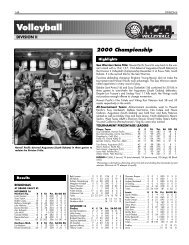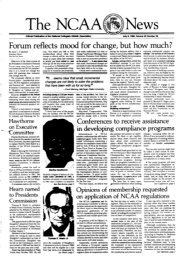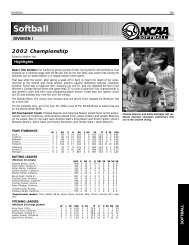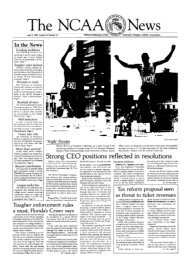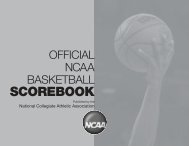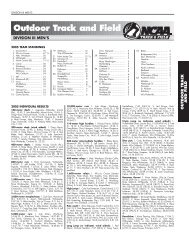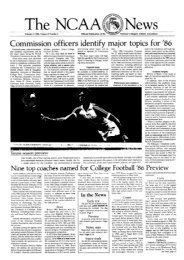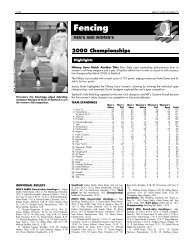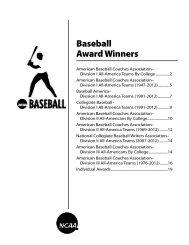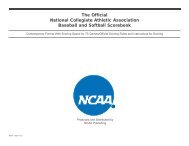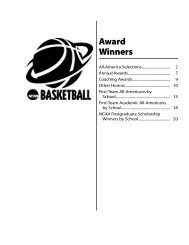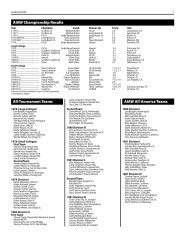Sports Medicine Handbook - NCAA
Sports Medicine Handbook - NCAA
Sports Medicine Handbook - NCAA
You also want an ePaper? Increase the reach of your titles
YUMPU automatically turns print PDFs into web optimized ePapers that Google loves.
“Burners” (Brachial Plexus Injuries)<br />
ervation of the epineurium, perineurium,<br />
and endoneurium,<br />
which can serve as the conduit<br />
for the regenerating axon as it<br />
re-grows at 1 to 7 millimeters<br />
per day. Weakness can last for<br />
weeks but full recovery typically<br />
occurs. Grade 3 in juries,<br />
neurotmesis or complete nerve<br />
transections are rare in athletes.<br />
Surgical repair of the nerve is<br />
required in these cases and complete<br />
recovery may not occur.<br />
These classifications have more<br />
meaning with regard to anticipated<br />
recovery of function than a grading<br />
on the severity of symptoms at the<br />
time of initial injury.<br />
Treatment and<br />
Return to Play<br />
Burners and stingers typically<br />
result in symptoms that are sensory<br />
in nature, frequently involving the<br />
C5 and C6 dermatomes. All athletes<br />
sustaining burners should be<br />
removed from competition and<br />
examined thoroughly for injury to<br />
the cervical spine and shoulder.<br />
All cervical roots should be<br />
assessed for motor and sensory<br />
function. If symptoms clear within<br />
seconds to several minutes and are<br />
not associated with any neck pain,<br />
limitation of neck movement or<br />
signs of shoulder subluxation or<br />
dislocation, the athlete can safely<br />
return to competition. It is important<br />
to re-examine the athlete after<br />
the game and for a few successive<br />
days to detect any reoccurrence of<br />
weakness or alteration in sensory<br />
exam.<br />
If sensory complaints or weakness<br />
persists for more than a few minutes,<br />
a full medical evaluation with<br />
radiographs and consideration for a<br />
MRI should be done to rule out<br />
cervical disk or other compressive<br />
pathology. If symptoms persist for<br />
more than 2 to 3 weeks, an EMG<br />
may be helpful in assessing the<br />
extent of injury. However, an EMG<br />
should not be used for return-toplay<br />
criteria, as EMG changes may<br />
persist for several years after the<br />
symptoms have resolved. Shoulder<br />
injuries (acromioclavicular separation,<br />
shoulder subluxation or dislocation,<br />
and clavicular fractures)<br />
should be considered in the differential<br />
diagnosis of the athlete with<br />
transient or prolonged neurologic<br />
symptoms of the upper extremity.<br />
Any injured athlete who presents<br />
with specific cervical-point tenderness,<br />
neck stiffness, bony deformity,<br />
fear of moving his/her head and/<br />
or complains of a heavy head<br />
should be immobilized on a spine<br />
board (as one would for a cervical<br />
spine fracture) and transported to a<br />
medical facility for a more thorough<br />
evaluation.<br />
Bilateral symptoms indicate that<br />
All athletes sustaining<br />
burners or stingers<br />
should undergo a<br />
physical rehabilitation<br />
program that includes<br />
neck and trunk<br />
strengthening exercises.<br />
The fit of shoulder pads<br />
should be re-checked and<br />
consideration of other<br />
athletic protective<br />
equipment, such as neck<br />
rolls and/or collars,<br />
should be given. The<br />
athlete’s tackling<br />
techniques should be<br />
reviewed.<br />
51



